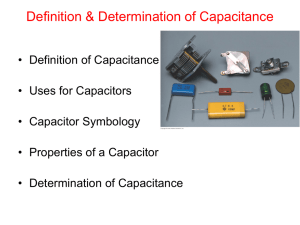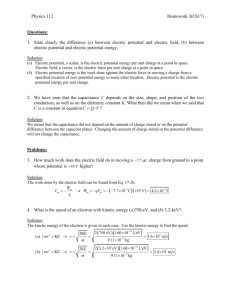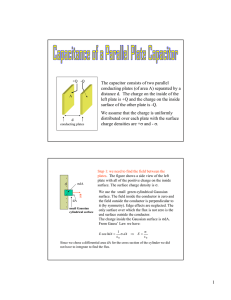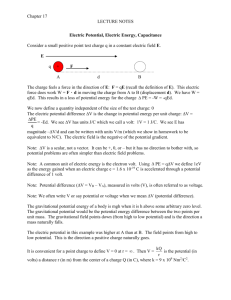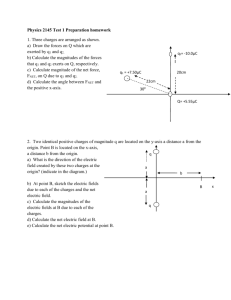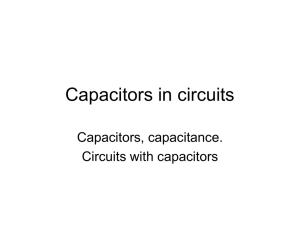T O P S
advertisement
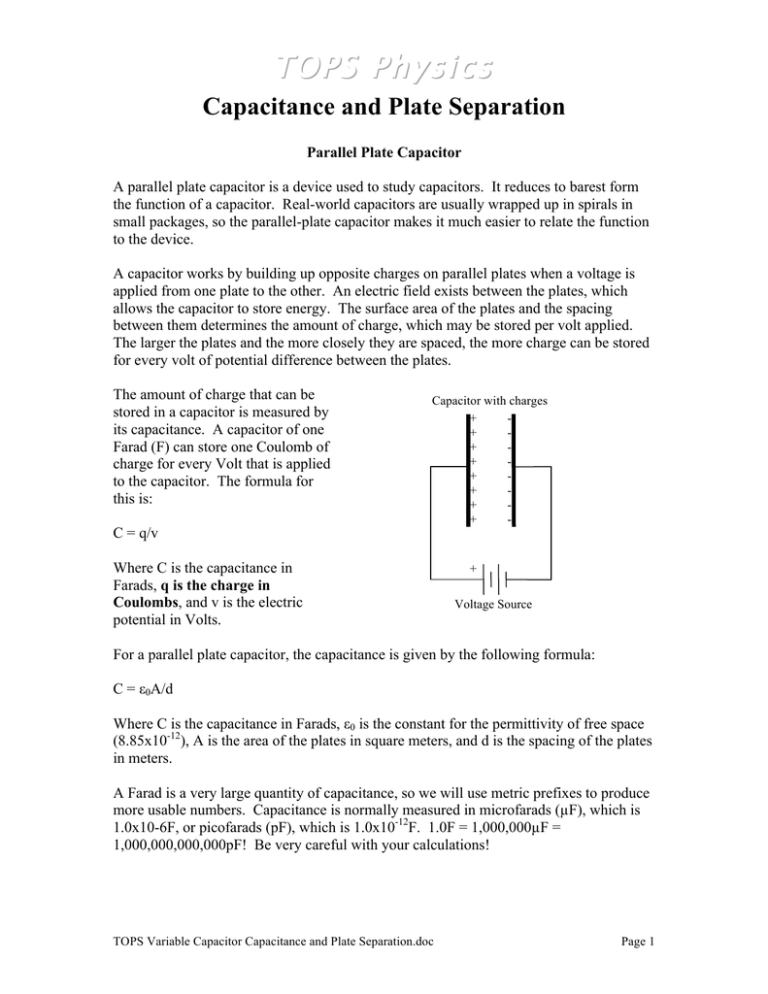
TOPS Physics Capacitance and Plate Separation Parallel Plate Capacitor A parallel plate capacitor is a device used to study capacitors. It reduces to barest form the function of a capacitor. Real-world capacitors are usually wrapped up in spirals in small packages, so the parallel-plate capacitor makes it much easier to relate the function to the device. A capacitor works by building up opposite charges on parallel plates when a voltage is applied from one plate to the other. An electric field exists between the plates, which allows the capacitor to store energy. The surface area of the plates and the spacing between them determines the amount of charge, which may be stored per volt applied. The larger the plates and the more closely they are spaced, the more charge can be stored for every volt of potential difference between the plates. The amount of charge that can be stored in a capacitor is measured by its capacitance. A capacitor of one Farad (F) can store one Coulomb of charge for every Volt that is applied to the capacitor. The formula for this is: C = q/v Capacitor with charges + + + + + + + + - Where C is the capacitance in Farads, q is the charge in Coulombs, and v is the electric potential in Volts. + Voltage Source For a parallel plate capacitor, the capacitance is given by the following formula: C = ε0A/d Where C is the capacitance in Farads, ε0 is the constant for the permittivity of free space (8.85x10-12), A is the area of the plates in square meters, and d is the spacing of the plates in meters. A Farad is a very large quantity of capacitance, so we will use metric prefixes to produce more usable numbers. Capacitance is normally measured in microfarads (µF), which is 1.0x10-6F, or picofarads (pF), which is 1.0x10-12F. 1.0F = 1,000,000µF = 1,000,000,000,000pF! Be very careful with your calculations! TOPS Variable Capacitor Capacitance and Plate Separation.doc Page 1 TOPS Physics Purpose: The purpose of this lab is to investigate the relationship between plate separation and capacitance of a parallel plate capacitor. Equipment: Variable capacitor Digital multimeter Capacitance Tester (short leads that plug into multimeter) Graph Paper Cautions: This equipment is delicate. Everything should go together with the lightest of touches. Do not force anything! Procedure to set up the variable capacitor 1. Place the variable capacitor in the middle of the lab table, with the 0cm mark to your left. Don’t put the capacitor too close to the edge of the table! 2. Place the multimeter close to the capacitor plates. You will find it most convenient to put the meter behind the capacitor. 3. Plug the capacitance tester into the Cx socket on the multimeter. One pin of the tester goes into each of the slots of the Cx socket 4. Put the plates at 5 mm separation (Align the left edge of the plastic tab that extends toward the scale with the 5mm mark on the scale). Note that the scale is calibrated in cm, so the 5mm mark will be halfway between 0cm and 1cm. 5. Clip the leads of the capacitance tester to the plates of the capacitor. The best place to clip them is onto the radial flanges on the backside of the plates. There are binding posts present, but the flanges work better! The meter and leads themselves have some capacitance (about 4pF), so the leads have to be kept short. Try to keep the leads as far away from each other as you can. This value will have to be subtracted out of all your experimental readings. 6. Turn the big dial on the multimeter to “2000p”. This turns the meter on and adjusts it to read in picofarads (pF). A picofarad is 1.0x10-12 farads. 7. Get everyone away from the apparatus; let the meter settle to a constant reading and record the reading in the “Experimental Capacitance” column in the 5mm row. 8. Repeat this procedure moving the plates 5 mm further apart for each measurement until you reach 65 mm. Record each measurement in the table. When the reading becomes less than 15pF, you should change to the 200pF scale for more accuracy. TOPS Variable Capacitor Capacitance and Plate Separation.doc Page 2 TOPS Physics Plate separation ( mm ) Experimental Capacitance Minus 4 pF ( pF) Theoretical Capacitance ( pF) Difference in Capacitance (pF) % Error 5 10 15 20 25 30 35 40 45 50 55 60 65 Data analysis: You must calculate the theoretical capacitance for each spacing. We’ll do the first one, and then you can do the rest! The hardest part of this is getting the units right. The easiest way to proceed is to put everything in meters for the calculations: 1. The diameter of the capacitor plates in centimeters should be 17.8cm. 2. Divide the diameter by 100 to put the measurement in meters. The result is 0.178m. Divide this by two to get the radius: 0.089m 3. The area of the plate is determined by the common formula A=πr2. Plug in the numbers to get A = π(0.089)2 = 0.0249m2 4. Convert the plate spacing (5mm) to meters by dividing by 1000. 5/1000 = .005m. 5. Use these numbers in the formula C = ε0A/d to determine the theoretical capacitance thus: C = 8.85x10-12(.0249)/.005 = 4.40x10-11. This is equal to 44.0x10-12F or 44.0pF 6. Write this result (44.0pF) in the “Theoretical Capacitance” column and the 5mm row. 7. Repeat this process for the other plate spacings. Note that the plate area is the same for all, so all you need to do is repeat steps 5 and 6, inserting the correct values for the spacing in each case. 8. For each plate spacing in the table, find the difference between the experimental and theoretical values by subtracting each theoretical value from each experimental value. Record the difference in the table. 9. Now you will calculate the experimental error for each spacing. Just use the formula: E=(Theoretical Value-Experimental Value) x100/Theoretical Value. For example, at the 5mm setting, if your theoretical value is 44.0pF and your experimental value is 61.1pF, you just plug these into the formula: E = (44.0-61.1) x100/44.0 = -38.9%. Take the absolute value of this number (38.9%) and record it in the “% Error” column of the table. TOPS Variable Capacitor Capacitance and Plate Separation.doc Page 3 TOPS Physics 10. On graph paper, plot the plate spacing on the x (horizontal) axis versus the capacitance on the y (vertical) axis. Plot both the theoretical value and the experimental value, using either different colors or line styles to distinguish the two curves. Make sure that you choose appropriate scales and label the axes and scales clearly. It is best to orient the paper with its long axis in the horizontal direction (“landscape mode”). 11. Examine your graph and answer the following questions: a. Does your experimental data support the theoretical values? Why? b. Can you explain the experimental error? c. Which set of data is more helpful in understanding the reasons behind the experimental error, the difference between the experimental and theoretical values or the percentage of error? Explain why you feel this way. d. Is it possible to change the value of the capacitor without changing the size or spacing of the plates? (Hint: think about what happened to the reading when you were physically close to the capacitor!) TOPS Variable Capacitor Capacitance and Plate Separation.doc Page 4

